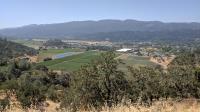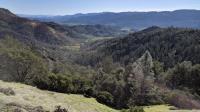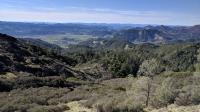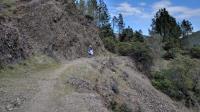History

A view over Napa Valley vineyards and Calistoga only one mile into the hike.
This scenic path through the mountains overlooking Napa Valley was not put into place to provide a vigorous outing by locals and visitors, though it does, and the path was not chosen to highlight spectacular views over wine country, though they do exist. Rather, the road was put in place to support mining operations in the area and to avoid the high fees charged by nearby private roads.
There's no gold in these hills (well, not in usable quantities) but Cinnabar, a red shiny mineral that contains mercury sulfide. The mercury extracted from the rock would often be used for some gold mining operations. The trail's namesake Oat Hill Mine was at one point the sixth largest mine of its kind in the world.

The trail features some nice views within the first mile of the trailhead, but if you go higher the views of Napa Valley get better.
Getting the ore out of the area proved to be time consuming and costly. No easy routes from the mines to the railhead in Calistoga existed. An initial route required the paying of a toll to travel along a private roadway. The path that became known as the Oat Hill Mine Trail was a publicly funded path that took 20 years to go from concept to completion in 1893.
Alternate routes opened up and by the 1930's and 1940's traffic along the road dwindled. Maintenance on the road ceased. On top of that, mining at Oat Hill and other sites in the area started to wind down their operations by the 1960's. Homesteaders along the path moved out or sold to developers who eventually made futile efforts to build housing projects on the hills.
Though abandoned by miners and residents, the path became the playground for off road vehicles and hunters looking for a quicker path into the backcountry. The noise and deaths that occurred from jeeps driving on the ever more perilous path led the county and community to repurpose the trail for hikers and cyclists.
The Trail

The trail crosses over the spine of a ridge and opens up views of Napa Valley more to the north.
The main trailhead lies along Highway 29 near the intersection with Silverado Trail. There are very few parking spaces here and most spots are likely to be filled up on the weekend. Be prepared to park along the road. If parking on the opposite side of the highway be sure to cross with care.
The trail is nearly continuously ascending from the trailhead and thus can be challenging. The trail surface starts out muddy and can get a bit squishy after a rain. But the softer surface will soon give way to a consistently rocky path for the remainder of the trail. Farther up the hill, on trail surfaces consisting of solid rock, be on the lookout for ruts carved into the rock by the metal covered wheels of the wagons used to haul supplies and ore over the path.
Decent views over part of Napa Valley are available at the half mile and 1 mile points of the trail for those looking for a quicker outing. And what would one expect to see when looking over Napa Valley from above? Vineyards, of course!
There are mile markers every mile and at trail junctions where they do occur. What is a little odd is that there are two markers for mile 1! Both appear very official and roughly the same age. According to our GPS we recorded the markers at approximately .97 and 1.08 miles. So split the difference! Who's to say which one is right?

Many segments of the trail hug a steep rock wall on one side.
For the first couple of miles there is decent tree cover over a good portion of the trail intermixed with open segments. That begins to change after about 2.5 to 3 miles where the terrain becomes even rockier and fewer trees means more Sun beating down on the traveler. The upside of this becomes the more frequent views over ever larger swaths of the valley. As one looks uphill you'll also see more dramatic rock formations either along the trail itself or along the Palisades to the northwest leading towards
Robert Louis Stevenson State Park.
A close look at the rock formations along the trail give hint to some of the volcanic activity that formed the area.
There's a mix of vegetation that varies by distance from the trailhead and the elevation as one progresses along the trail. Grey Pines feature prickly pine cones the size of softballs. The larger ones could do some serious damage if they fell on a person's head.
At the midpoint of the trail, approximately 5 miles from the trailhead, sits Holm's Place. Karl Gustov Holm acquired 160 acres along Oat Hill Mine Road and built a log cabin in this mountain pass in 1893. A new house was built in 1896 and other structures including a barn were added to the mix. Only a few low wall and foundation stones remain of the complex of buildings that once were here.
Walking up to Holm's Place the rocky, desolate trail does not provide much confidence that someone could make a living from farming here. But the saddle of land in the shadows of the Palisades flattens out and provides suitable soil for agricultural pursuits such as growing fruit trees. A few of Holm's apple trees are said to survive to this day.
The back half of the trail leads from Holm's Place to the trailhead at Aetna Springs Road. The trailhead there starts a bit higher than 2200 feet above sea level, which means it should be less vertically challenging and even a bit shorter on top of that. The two downsides with that segment of the trail is that getting to the trailhead is more difficult and it's also closed from late summer into fall due to high fire hazards and deer hunting season. Be sure to check for trail availability before heading out during that time of year.